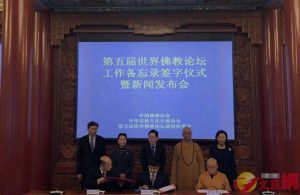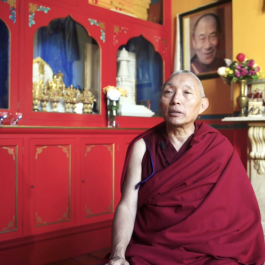
The core truth of the Dhamma can be uncovered only gradually, through patient attention and persistent endurance. The Buddha taught that realization of the truth does not come suddenly, in a flash, to an undeveloped, untrained mind, like a bolt out of the blue.
On the contrary, the development of the Buddhadhamma can be compared to undertaking a long journey, through escalating steps and stages, making gradual progress on the vast map of psycho-physical comprehension, before the figurative traveler can come within sight of the ultimate destination.
In what follows below, I shall quote, paraphrase, and comment on passages from Thanissaro Bhikkhu’s English translations from the Pali in an essay titled “Dhamma.”*
“Just as the ocean has a gradual shelf, a gradual slope, a gradual inclination, with a sudden drop-off, only after a long stretch, in the same way, this doctrine and discipline (dhamma-vinaya) has a gradual training, a gradual performance, a gradual progression, with a penetration to gnosis only after a long stretch.” — Ud 5.5 Uposatha Sutta
And how is there the attainment of awakening after gradual training, gradual action, and after gradual practice?
There is the case that once a monastic’s conviction has been sufficiently developed, they visit a teacher to whom they grow close. Having grown close, they listen. Having listened, they hear the Dhamma. Having heard the Dhamma, they remember it. Keeping the Dhamma in mind, they penetrate the meaning of the teachings. Penetrating the meaning, they develop conviction through pondering the teachings. There being understanding through pondering the teachings, a desire to develop arises. When a desire to develop has arisen, they are eager to make the effort. Thus eager to make the effort, they contemplate. Having contemplated, they make an exertion. Having made an exertion, they realize the truth, and having penetrated the truth with discernment, they finally see, know, and understand the ultimate truth.**
The Buddha’s method of “gradual instruction” (anupubbikatha), which appears in the suttas, follows a course of developing stages. The Buddha guides newcomers from first principles, through a series of ever-more-advanced teachings, finally through to fulfillment of the Four Noble Truths and realization of nibbana.
Let’s begin to break this down:
The Blessed One, having heightened consciousness of the scope of minds within the gathered assembly before him, asked himself:
“Now who here is capable of understanding the Dhamma?”
He saw Suppabuddha, the leper, sitting in the assembly, and on seeing him the thought occurred to him:
“This person, here before me, is capable of understanding the Dhamma.”
The Buddha then gave a step-by-step talk, directed to Suppabuddha, the leper, focused upon virtue and heaven, declaring the drawbacks, degradation, and corruption of sensual passions on the one hand, and the rewards of renunciation on the other.
When he understood that Suppabuddha the leper’s mind had become ready, malleable, free from hindrances, elated and bright, the Buddha then gave a Dhamma talk, directed to Suppabuddha, as an Awakened One, about stress, its origination, and its cessation through practicing the noble path.
And just as a clean cloth, free of stains, would absorb dye, in the same way, as Suppabuddha, the leper, was sitting there listening, the dustless, stainless Dhamma eye arose within him and he understood that:
“Whatever is subject to origination is also subject to cessation.”***
At each stage of gradual training, the practitioner discovers a new dimension of the law of cause and effect or kamma as the cornerstone of Right View. This is an illuminating framework within which to view the unfolding of the Buddha’s teaching.
The gradual training continues with the cultivation of generosity and working on the process of weakening of an unawakened practitioner’s habitual tendencies of clinging to views, sensuality, and unskillful modes of thought and behavior.
This is followed by the cultivation of virtue as the basis of sense-restraint, which helps the practitioner to develop a healthy, trustworthy sense of being an observer. The peace of mind born from this level of self-respect—being based on right action—provides a solid foundation for even further progress along the path.
Next, the practitioner begins to understands that some forms of happiness are deeper and more dependable than anything that a feeling of sense-gratification and self-satisfaction can provide. Indeed, the happiness born of generosity and virtue can lead to rebirth in heaven. However, as time passes, the practitioner begins to recognize the intrinsic drawbacks of this form of happiness.
No matter how good rebirth in such wholesome states may be, the happiness enjoyed can never be true and lasting happiness because it still relies on temporary conditions over which the practitioner has no control.
This then marks a crucial turning point in the training once the practitioner finally grasps that true happiness cannot be found within the physical and sensual realm.
Instead, the one possible path to unconditioned happiness lies in turning away from the sensual realm in renunciation, trading the familiar and lower forms of sense-happiness for something higher, more rewarding, and noble. The practitioner becomes ripe to comprehend the teachings of the Four Noble Truths, which explain the path to the culmination of mental training to attain the highest happiness of nibbana.
The meaning is clear: to reap the most benefit from meditation practice, to bring to full maturity all of the qualities needed for liberation and awakening, the fundamental groundwork and gradual training cannot be overlooked. There can be no short-cut or easy way of jumping to the end of the process. The mind develops gradually, until it is finally ripe enough to take one last leap toward Awakening.
It would take a big book to cover everything in detail, but below is an outline of the six stages of gradual training, which can only be known by doing.
- 1. Generosity (dana)
- 2. Virtue(sila)
- 3. Heaven (sagga)
- The Thirty-one Planes of Existence
- 4. Drawbacks (adinava)
- 5. Renunciation (nekkhamma)
- 6. The Four Noble Truths(cattari ariya saccani)
- A. The Noble Truth of Dukkha (dukkha ariya sacca)
- • Dukkha
- • The round of rebirth (samsara)
- B. The Noble Truth of the Cause of Dukkha (dukkha samudayo ariya sacca)
- • Craving (tanha)
- • Ignorance (avijja)
- C. The Noble Truth of the Cessation of Dukkha (dukkha nirodho ariya sacca)
- • Nibbana
- D. The Noble Truth of the Path Leading to the Cessation of Dukkha (dukkha nirodha gamini patipada ariya sacca) — The Noble Eightfold Path. The Commentaries group the eight path factors into three divisions:
- Discernment (pañña):
- 1. Right View(samma-ditthi)
- 2. Right Resolve (samma-sankappo)
- Virtue (sila):
- 3. Right Speech (samma-vaca)
- 4. Right Action (samma-kammanto)
- 5. Right Livelihood (samma-ajivo)
- Concentration (samadhi):
- 6. Right Effort (samma-vayamo)
- 7. Right Mindfulness (samma-sati)
- 8. Right Concentration(samma-samadhi)
* “Dhamma”, edited by Access to Insight. Access to Insight (BCBS Edition), 30 November 2013, http://www.accesstoinsight.org/ptf/dhamma/index.html
** See MN 70 Kitagiri Sutta
*** See Ud 5.3 Kutthi Sutta
See more
Sutta Nipāta (budaedu.org)
Related features from BDG
Persistence in Practice
The 10 Qualities of Protection
Food for the Mind














